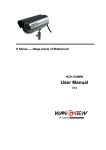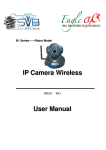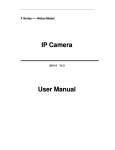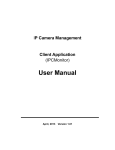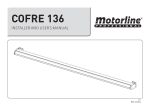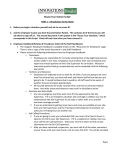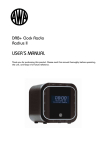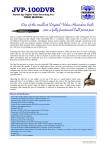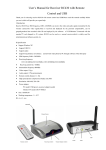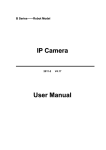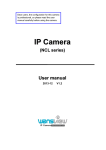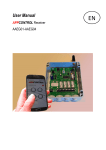Download IPCMonitor User Manual
Transcript
IP Camera Centralization Management Client Application (IPCMonitor) May, 2012 Version 1.3 User Manual INDEX 1 Introduction...........................................................................................................................3 2 Computer Requirement.........................................................................................................3 3 Installation.............................................................................................................................4 4 Device Management..............................................................................................................4 4.1 Adding A Device..............................................................................................................5 4.2 Adding Multiple Devices in LAN......................................................................................7 4.3 Modifying Devices...........................................................................................................7 4.4 Deleting Device...............................................................................................................8 4.5 Further Notifications for Device List Window.................................................................8 5 Video view.............................................................................................................................8 5.1 Start the Video................................................................................................................9 5.2 Alarm Trigger..................................................................................................................9 5.3 Video Recording Trigger................................................................................................10 5.4 Stop the Video..............................................................................................................10 6 Device Control.....................................................................................................................10 6.1 Base Operation.............................................................................................................10 6.2 Device Control Panel.....................................................................................................11 7 Channel Management.........................................................................................................11 8 Other Settings......................................................................................................................12 8.1 System Setting...............................................................................................................12 8.2 History Log....................................................................................................................13 9 Further Notifications............................................................................................................13 1 Introduction IPCMonitor is a centralization management software provided by the manufacturer. It provides the central control of monitoring, video capture, alarm testing, etc for multiple IP cameras on LAN or WAN. Before using this software, please ensure the devices can be access by web browsers from LAN or WAN, please consult the user manual of the IP Camera to know the IP Camera belongs to which series(support Q/B/H series products). This article provides a how-to on viewing the IP Camera's video by using this dedicated client application. 2 Computer Requirement Using IPCMonitor, your computer should meet the following configuration: CPU: Dual-core CPU RAM: 1GB or above Hard disk: 160GB or above OS: “Windows XP or higher Resolution of display: ≧1024*768 3 Installation Figure 1: Application User Interface Insert the bundled CD to the drive, double click IPCMonitor, a pop-up window will be shown, please follow the instruction on the window to finish the software installation. After a successful installation, run the application and the user interface will be shown as Figure 1. 4 Device Management The following steps are required before using this application: 1) Plan and install the IP Camera(s) which intend to be monitored. 2) Login to the IP Camera(s) by web browser and set the IP address, port, username & password, alarm setting, system time etc. 3) DDNS setting is a plus whenever you intent to visit the devices by WAN. In this application, Device Management tab is shown as Figure 2: Figure 2: Devices Management 4.1 Adding A Device 1) Basic configuration Figure 3: Adding A Device tab Click the button shown on Figure 2, information of the device will be prompted to input. As of Figure 3: device name is unique (operation will be denied in case name conflicts) in Device Management, and once set, it is recommended not to be changed. Choose the right product series(Required). The fields 'Domain/IP', 'Port', 'Viewing Username', and ‘Viewing Password' are required. Test the connection from web browser. Since the device is connected to WAN, IP address can be instead by a domain name. 2) Alarm Setting Alarm mode can be set by clicking on the Alarm Setting tab, as of Figure 4. Enabling the alarm, check the 'Enabled alarm' first. Figure 4: Alarm Setting Select “All time” or “Schedule armed”,then fill out the Trigger and Action blank. Note: Before alarm setting, please make sure the ip camera’s configuration is correct and it could detect the alarm. (refer to the ip camera user manual) During the armed period, alarm action like siren, snapshot or video recording will be taken once the trigger meets. 3) Record Scheduling Video recording can be scheduled by clicking on the Record Scheduling tab. The device will perform video recording automatically according to the schedule, as of Figure 5. Figure 5: Record Scheduling 4.2 Adding Multiple Devices in LAN Multiple devices within the LAN can be added by clicking the button. A sample is shown in Figure 6. Select the product series and click “Search”, the found devices will be listed. Tick the checkbox on the device which going to be added, assign a name and set the viewing username and password. Click “OK” , then the device is put in the device list. Figure 6: Add Multiple Devices NOTICE: In case a firewall is running on the computer, by the time clicking the “search” button, a window would pop-up asking whether block or unblock the application, please click 'unblock'. 4.3 Modifying Devices Modify the setting of a device by selecting the device and click button. The modifying window is same as 'Adding A Device' window. It can change the device data, alarm setting and record setting. When modifying a device name, click the down arrow and select 'Modify device name' from the drop list. As of Figure 7. Figure 7: drop list 4.4 Deleting Device Delete a device by selecting it and click the button. When deleting all the devices, click the down arrow on the right side and select 'delete all devices' from the drop list. 4.5 Further Notifications for Device List Window 1) After adding a device, right click on the device and select open browser, a browser window will be opened and auto login to the device. In case the login fails, the device may be offline or the device info is incorrect. 2) A 3) A icon will be shown on the right side of a device, in case alarm is enabled. icon will be shown on the right side of a device, in case video recording is scheduled. 4) If you double click and area, it will pop up the alarm and record setting window. 5) The last column of the list is to display alarm,double click this area,It will present the device’s alarm. Figure 8 Device list 5 Video view After adding devices, IPCMonitor doesn't work until the related devices are started. IPCMonitor provides the following operation/functions: display the devices video, arm the devices, and decide when to start a scheduled video recording, response to user's command. 5.1 Start the Video Video can be start by the following three methods: Select and double click on a device needed to be started; a free channel will be taken to show up the video. Select a device and click the button will start it as well. By clicking on the down arrow, start all the devices command can be found on the drop list. Select a device, drag and drop it to a channel, it will show up the video in this channel. Device name will be shown in green on the status bar when it's started. In case the device is offline, or IP address, port, viewing username or password is wrong, the connection could not be established, and related information will be pop-up. 5.2 Alarm Trigger 1) After started a video, the application will detect the device to determine if there's any alarm occurred. 2) Whenever an alarm is detected, the application will check the armed time, once the alarm is within an armed time, alarm action will be taken. 3) When a icon twinkling on the device field, means an alarm action is being taken, click on the icon can stop the siren. 4) When a appears but not twinkling, means there was an alarm, double click on the icon will pop-up a recent alarm list. The icon will disappear by closing the alarm list. The alarm list window is as Figure 9. Figure 9: Alarm List window 5) Even the video alarm recording trigger is set, it will not take any effect in case it is taking a scheduled recording job or capturing a video manually by the time an alarm activated. 6) In case snapshot trigger is set, the file name will be started with an A prefix following by the time stamp as the other part, the suffix is .JPG. 7) Please refer to chapter 8.1 for the option of alarm action. 5.3 Video Recording Trigger 1) The application can perform 3 types of video recording , the alarm video recording (set in Figure 4), scheduled recording (set in Figure 5) and manual recording (by clicking on the record button in Figure 10). The manual recording has top priority, scheduled recording takes second, then alarm recording. Example: If a manual recording is initialed by the time an alarm is activated, the application will stop the alarm recording first then start the manual recording. When performing a scheduled video recording, an alarm is activated, the application will not response to the alarm recording request. 2) Prefix of A, M and S will be set to the file name according to alarm recording, manual recording and scheduled recording, time stamp will fill up the other part and ends up with .avi (H series products’ suffix is.asf) 3) Whenever the recording time is longer than one hour for manual recording or scheduled recording, a new file will be created for each hour. 5.4 Stop the Video A video can be stopped by the following two methods: 1) Select a started device and click the button can stop it's video. All devices can be stopped by clicking on the down arrow and select “stop all video” from the drop list. 2) Right click on a channel and select stop video from the pop-up menu to stop it. 6 Device Control Select a video channel from the display area directly, and you can control the device of this channel. 6.1 Base Operation 1) Double click on a channel will stretch the video to full screen. By double clicking it again, the video will shrink back to its original size. 2) Click and hold a channel can drag and drop it to another channel, in case the target channel is utilized, the two video channels will swap. 3) By right clicking on a channel, user can perform some operations like stop video, stretch, etc from the pop-up menu. 4) By clicking on the icons in the status bar for each channel, you can snapshot or record manually. Due to different functions, every series product has its own icon content. Status bar of B Series is as Figure 10, it displays the frame rate is 20.5, click these icons, talkback, sound intercepting, snapshot and manual video recording can be performed accordingly. Figure 10: Channel Status Bar Note, the talkback icon is disabled in case another user is utilizing the talkback function. User can only talk to and intercept the sound from the device according to current channel. A window will pop-up after a snapshot, take more snapshot or delete snapshot can be performing within the window. The file name for manual snapshot will start with M, time stamp as the rest, then .JPG as ending. 6.2 Device Control Panel Device control panel can be accessed by clicking on 'device control' at the lower right corner or pressing space. 1) You can look up the current channel device information in the Device Control Panel, including: device name and device IP address. 2) The Pan/Tilt can turn up, down, left, right by clicking on the arrows accordingly in the “PTZ Control” area. You also use keyboard to control Pan/Tilt, like as: ← → ↑ ↓; 3) Part of H Series IP Camera, like High Speed Dome , to click can control Zoom; 4) Part of H Series IP Camera, if it has connected a Pan/Tilt, to click: You will Set/Call the preset; and click auto, the Pan/Tilt will cruise according the preset; and click stop, the Pan/Tilt will stop cruise; 5) A window will pop-up by clicking the 'advanced' button, for the purpose to set up the video compress parameter such as definition, bit rate control, etc 7 Channel Management For the purpose of better video viewing, multiple channel switches are provided. There are switch buttons above the device and channel management panel, shown as Figure 11. Figure 11: Channel Switch Buttons The application can provide up to 16 channel videos; it can manage up to 64 devices simultaneously. 8 Other Settings On the top of “Device Management” and “ Device Control”, there are “System Setting”, ”History” and “About” three buttons. 8.1 System Setting Figure 12: System Setting System Setting window is shown as Figure 12. Following are some notifications for this window. 1) About alarm settings: In the 'Alarm action settings' section, user can select other sound file (.wav) as siren sound. The default sound will be used in case this field is blank. Users can also configure “Siren Duration, Snapshot Number, Record Duration” data. 2) About storage location:: User can define the picture and video files storage location, leaving this field blank the default location is the application installation directory. Pictures and videos will be stored in. /snap, and. /record directory. If tick “Delete the oldest files When the disk space is insufficient”, when the disk space is less than 500M, this programmer will automatically delete the first day's data and then realize the cycle record function, or it will stop recording. 3) The other options: Play all the devices when running this software or not Stretch video from all channels or not Hide status bar or not Prompt before shutting down this system or not 8.2 History Log By clicking on the History Log, the video play will be opened, and enter the record directories, user can play the videos sorted by device name. 9 Further Notifications 1) Use administrator to login in your operating system, and then install the ipcmonitor software. 2) Before using this software, please ensure the devices can be access by web browsers from LAN or WAN, please consult the user manual of the IP Camera 3) When performing centralization monitoring, please open Windows Task Manager and check the percentage of CPU usage. If it take more than 80% of CPU usage, the CPU's performance may not be good enough, please refer to the third part in 6.2, click “advanced” and access video setting page to adjust the bitrates or resolution.
















